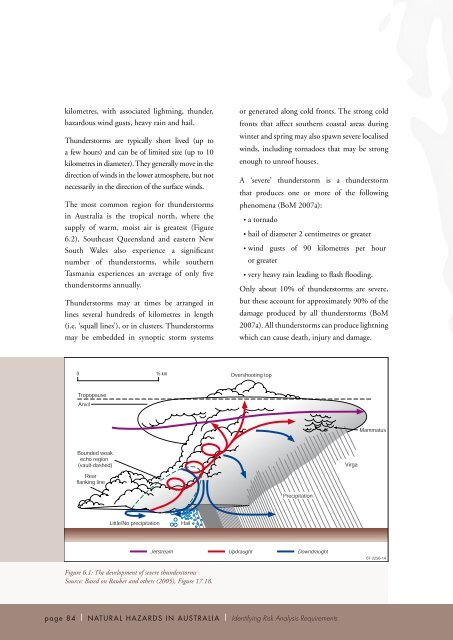Severe Storm - Geoscience Australia
Severe Storm - Geoscience Australia
Severe Storm - Geoscience Australia
Create successful ePaper yourself
Turn your PDF publications into a flip-book with our unique Google optimized e-Paper software.
kilometres, with associated lightning, thunder,<br />
hazardous wind gusts, heavy rain and hail.<br />
Thunderstorms are typically short lived (up to<br />
a few hours) and can be of limited size (up to 10<br />
kilometres in diameter). They generally move in the<br />
direction of winds in the lower atmosphere, but not<br />
necessarily in the direction of the surface winds.<br />
The most common region for thunderstorms<br />
in <strong>Australia</strong> is the tropical north, where the<br />
supply of warm, moist air is greatest (Figure<br />
6.2). Southeast Queensland and eastern New<br />
South Wales also experience a significant<br />
number of thunderstorms, while southern<br />
Tasmania experiences an average of only five<br />
thunderstorms annually.<br />
Thunderstorms may at times be arranged in<br />
lines several hundreds of kilometres in length<br />
(i.e. ‘squall lines’), or in clusters. Thunderstorms<br />
may be embedded in synoptic storm systems<br />
Figure 6.1: The development of severe thunderstorms<br />
Source: Based on Rauber and others (2005), Figure 17.18.<br />
or generated along cold fronts. The strong cold<br />
fronts that affect southern coastal areas during<br />
winter and spring may also spawn severe localised<br />
winds, including tornadoes that may be strong<br />
enough to unroof houses.<br />
A ‘severe’ thunderstorm is a thunderstorm<br />
that produces one or more of the following<br />
phenomena (BoM 2007a):<br />
• a tornado<br />
• hail of diameter 2 centimetres or greater<br />
• wind gusts of 90 kilometres per hour<br />
or greater<br />
• very heavy rain leading to flash flooding.<br />
Only about 10% of thunderstorms are severe,<br />
but these account for approximately 90% of the<br />
damage produced by all thunderstorms (BoM<br />
2007a). All thunderstorms can produce lightning<br />
which can cause death, injury and damage.<br />
page 84 | NATURAL HAZARDS IN AUSTRALIA | Identifying Risk Analysis Requirements

















